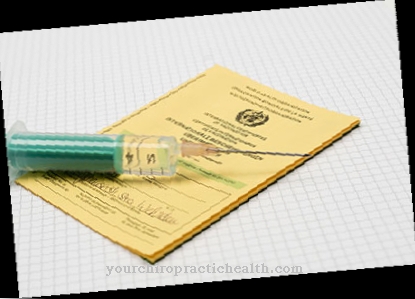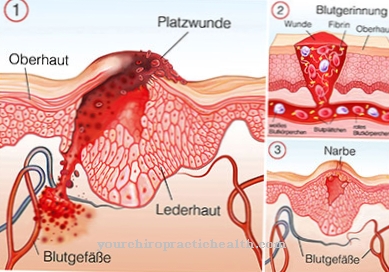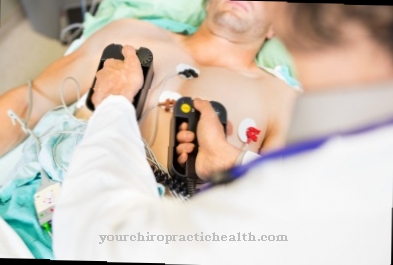Infections that can be transmitted from animals to humans are more common than expected. This problem is most common in Africa and India. But also in Europe there are cases of illness that are classified as Zoonosis are designated.
What is a zoonosis?
Under the term Zoonosis all infectious diseases that are transmitted between animals and humans are summarized.
The animals form the pathogen reservoir, while in most cases humans are the final link in this chain of infection. The most common zoonoses in Central Europe include salmonella enteritis, anthrax, brucellosis, leptospirosis, Q fever, yersiniosis and listeriosis.
More than 200 zoonoses are known worldwide. In particular, factory farming, which is common in technically highly developed countries, has promoted the spread of many zoonoses.
causes
A Zoonosis can be caused by viruses (bird flu, rabies), bacteria (salmonellosis, borreliosis), fungi (trichophytia), protozoa (toxoplasmosis, leishmaniasis) or worms (diphyllobothriasis, dirofilariasis).
The possible transmission paths are diverse. For example, zoonosis can occur through direct contact with infected animals, through animal foods such as milk, meat or eggs, and through pathogens known as vectors. These vectors do not cause the disease themselves and do not get sick from it. A well-known example of such vectors are, for example, ticks, which transmit early summer meningoencephalitis (TBE).
When the tick bites a person, the TBE virus is transmitted to the person. However, the sting itself is not the cause of the disease. This is also the reason why not everyone gets FMSE who has been bitten by a tick.
Symptoms, ailments & signs
Zoonosis can affect anyone. Often people with a previous illness are afflicted with severe symptoms. An illness can lead to life-threatening complications for them. Meningitis and others are possible. The signs are not clear, depending on the severity. Most of the time the skin is affected or there are symptoms that are reminiscent of flu.
Skin redness is widespread. These occur alone or are associated with headaches and fatigue. Nausea and diarrhea also set in. The most common zoonosis is toxoplasmosis. It leads to illness for several weeks before recovery without any medical help.
It is characterized by febrile conditions and swollen lymph nodes. The internal organs are also sometimes attacked in a zoonosis. If it is transmitted through food, the gastrointestinal tract is affected. Sick people complain of fever, abdominal pain and diarrhea.
Many people are familiar with the spread of salmonella. It causes a classic bowel disease. In some cases, such as Lyme disease, there is also joint and limb pain. Serious illnesses result in problems with the heart, liver and spleen. Sometimes symptoms can be seen in the nervous system.
Diagnosis & course
A detailed discussion about the previous course of the disease is necessary for the diagnosis of a Zoonosis vital. This conversation will be followed by a physical exam and possibly a blood test. The use of further diagnostic options depends on the type of suspected zoonosis. Depending on the symptoms, for the detection of the pathogen responsible for the zoonosis z. B. blood cultures, stool samples, bone marrow, samples from abscesses and lymph nodes are used.
Complications
The complications of zoonosis depend on the type of infection, the course of the disease, and other factors. Basically, viral diseases are associated with general symptoms such as fever, which can be life-threatening if not treated. Untreated bird flu often leads to severe pneumonia, while rabies can cause meningitis.
A zoonosis is almost always associated with reddening of the skin and side effects such as itching or bleeding. Blood poisoning can also occur as part of the transmission of disease from animals to humans. The specific complaints that arise depend on how severe the infection is and how quickly it is treated. Early treatment can usually prevent serious complications, but with rabies or bird flu, secondary symptoms and sometimes long-term effects are to be expected.
In the case of zoonosis therapy, the risks mainly come from the drugs prescribed. Antibiotics occasionally cause headache, muscle and joint pain, gastrointestinal complaints or skin irritations, and if taken for a long time, permanent damage to the internal organs is possible. In symptomatic treatment, the complications depend on the drug being prescribed.
When should you go to the doctor?
A doctor should always be consulted if the general state of health deteriorates. In particular, people with previous illnesses or a weakened immune system should seek the support and help of medical care as soon as they perceive impairments to their wellbeing. With them in particular, changes should be taken as soon as possible. A diffuse feeling of illness, fatigue or exhaustion are already among the complaints that should be examined. Nausea, vomiting, or diarrhea are also causes for concern. Disturbances in sleep, increased body temperature and abdominal pain should be presented to a doctor. If these irregularities persist for several days or if they increase in intensity and scope, a doctor should be consulted immediately.
Swelling of the lymph nodes, irregularities of the gastrointestinal tract or disorders of the heart rhythm must be treated by a doctor. In the case of a severe course of the disease, a zoonosis can lead to premature death of the person concerned. For this reason, patients at risk in particular are encouraged to discuss changes in their health with a doctor. If there is a headache, inner restlessness or joint pain, action is required. Cognitive changes and behavioral problems should also be presented to a doctor. Loss of appetite or a loss of body weight are some of the symptoms that require medical attention. Otherwise it can lead to an undersupply of the organism and secondary diseases.
Treatment & Therapy
Also the therapy one Zoonosis depends on their type. In the case of bacterial zoonoses, treatment is usually carried out by administering suitable antibiotics. Usually this is prescribed for several weeks, in the case of affected organs even longer.
As a rule, an effective antibiotic is determined in a laboratory. Most infections affecting the digestive tract are treated symptomatically by compensating for fluid and salt losses.
In these cases, with a few exceptions (meningitis, septicemia, permanent excretors, babies) antibiotics are not appropriate because they shorten the course of the disease, but prolong the excretion of germs.
prevention
Because one Zoonosis There may be many underlying causes, there are no universally valid measures for prevention. Good hygiene is generally an important protection against infectious diseases of all forms. Even washing your hands regularly and thoroughly with hot water and soap can prevent many infections.
The hygienic storage and preparation of food are equally important preventive measures. Heating or freezing food helps against some zoonoses such as teniosis or toxoplasmosis. Prions that z. B. cause the new form of Creutzfeldt-Jakob disease, but are very resistant and cannot be killed by such agents. Some zoonotic pathogens can be tackled by disinfection. These include, for example, influenza viruses.
In most cases, the infection with a zoonosis occurs through food. However, caution should also be exercised if zoonosis is detected in a pet. The best thing to do here is to clarify with the veterinarian in what form the pathogen can be transmitted and how long the animal is contagious. Thorough hand washing is essential after contact with a zoonotic animal. Cages, litter boxes, etc. must be cleaned every day in an animal with a zoonosis.
In general, when dealing with pets and farm animals, it is important to ensure that they are kept hygienic and appropriate to their species. Lice, ticks and mites should be removed as soon as possible and worm-prone animals should be dewormed regularly. In addition, some infections with a zoonosis can be prevented by appropriate vaccinations.
Many people become infected with zoonosis while traveling. It is therefore advisable to obtain precise information about the travel destination in advance and to take appropriate protective measures in the form of vaccinations or emergency medication.
Aftercare
Depending on how severe the symptoms were, the body is very weakened by a zoonosis. Therefore, everything that helps the patient to regenerate is recommended in aftercare. First and foremost, this includes a healthy lifestyle. Long walks in the fresh air and other physical activities are particularly advisable during the follow-up period.
They get the patient's circulation going without overstraining him at the same time. Of course, the patient should not put unnecessary strain on his immune system. Long disco evenings, smoking or excessive alcohol consumption are therefore not recommended. Instead, we recommend a regular sleeping and waking rhythm with fixed rest and getting up times.
A healthy diet is also part of aftercare. Food that is too fatty or too high in calories puts unnecessary stress on the body. Light, freshly cooked meals made from organically grown foods are advisable. The diet should be high in vitamins, minerals, and fiber. We recommend two liters of water a day to relieve the patient's liver and kidneys and to flush out possible toxins.
If the patient took an antibiotic to treat his zoonosis, it could have damaged the intestinal flora. Because a large part of the human immune cells are located in the intestine, probiotics are indicated in this case. A naturopathic doctor or alternative practitioner can recommend appropriate products.
You can do that yourself
The treatment of a zoonosis always belongs in the hands of a doctor. Depending on the type of zoonosis the patient has, therapy can be lengthy and difficult. Good compliance is now important: especially if antibiotics have been prescribed, the patient must absolutely adhere to the recommended dose and duration of treatment. At the same time, the patient can also watch out for possible undesirable side effects of antibiotic therapy, such as fungal infections on the skin. The faster they are discovered, the faster they can be treated and eliminated.
Zoonosis and its treatment can make the body very weak. Therefore, during the period of illness and convalescence, patients should ensure that they actively support the healing process, on the one hand by not burdening the body with additional toxins (alcohol, nicotine, exhaust gases, drugs, etc.) and on the other hand by allowing themselves sufficient rest . Eating a healthy diet also has a positive impact on recovery. A lot of exercise in the fresh air also activates the immune system.
Future sources of infection for a zoonosis should be eliminated if possible. This includes the hygienic preparation of perfect food as well as the regular deworming of your own pets and protection against ticks outdoors. Long trousers and the use of a repellent to protect against ticks are particularly advisable when taking a walk in the woods, especially in Germany's TBE risk areas.
























.jpg)



